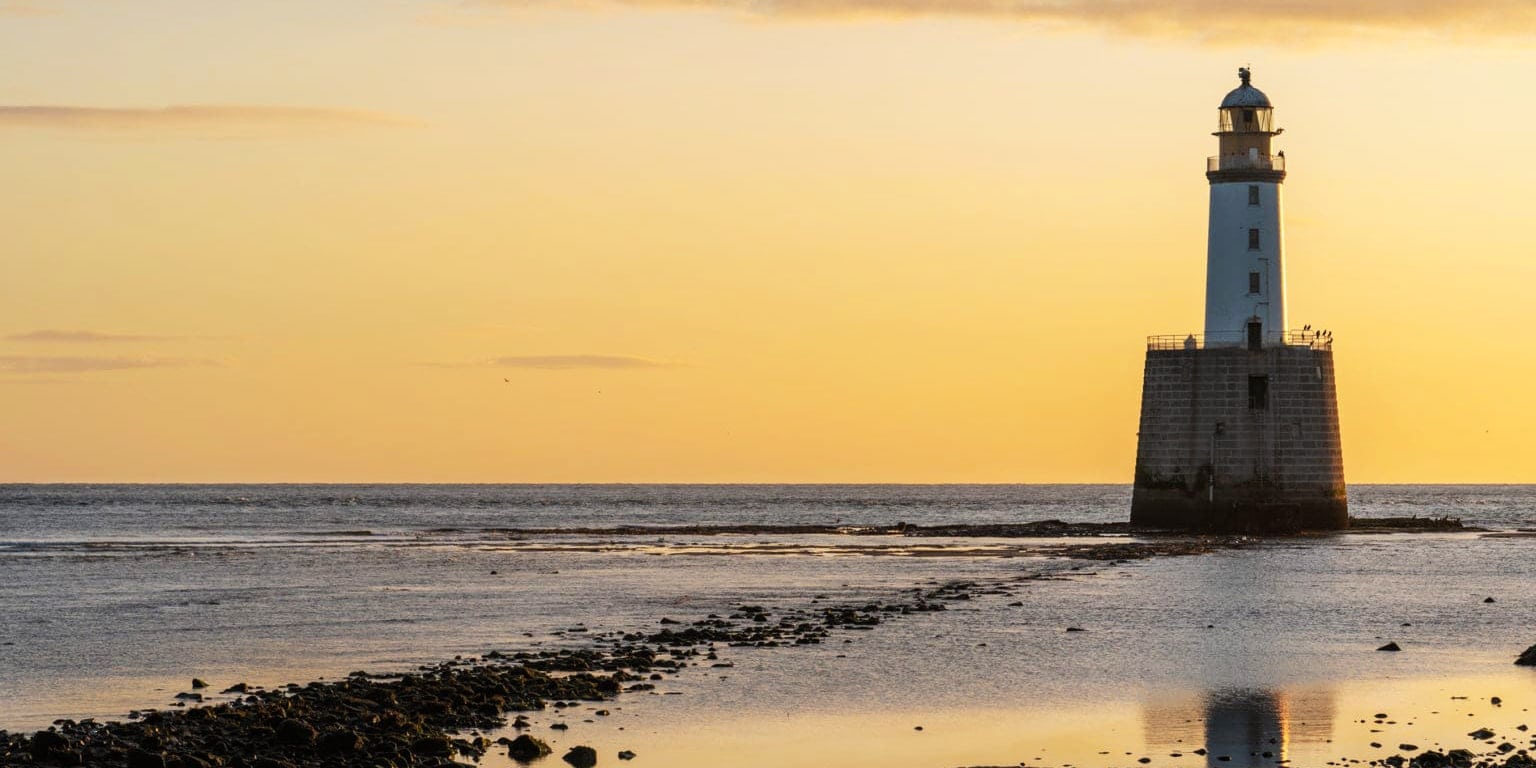Ever stumbled upon a place that instantly feels special? That’s Rattray Head for you.
During our year in Aberdeenshire, this spot became a favourite escape—think wide, open sands and the iconic Rattray Head Lighthouse as your only company.
It’s a paradise not just for photographers looking for that perfect shot but also for anyone wanting to step away from the usual tourist trails and enjoy a bit of quiet.
We’ve walked these beaches and felt the wind, and I can tell you, it’s as refreshing as it is beautiful. For more insights into Aberdeenshire’s hidden gems, check out our complete guide to Aberdeenshire’s castles and coastlines.
So, grab your jacket, and let’s dive into why visiting Rattray Head is more than just a check on the tourist list—it’s a genuine slice of the Scottish coast’s serene beauty.
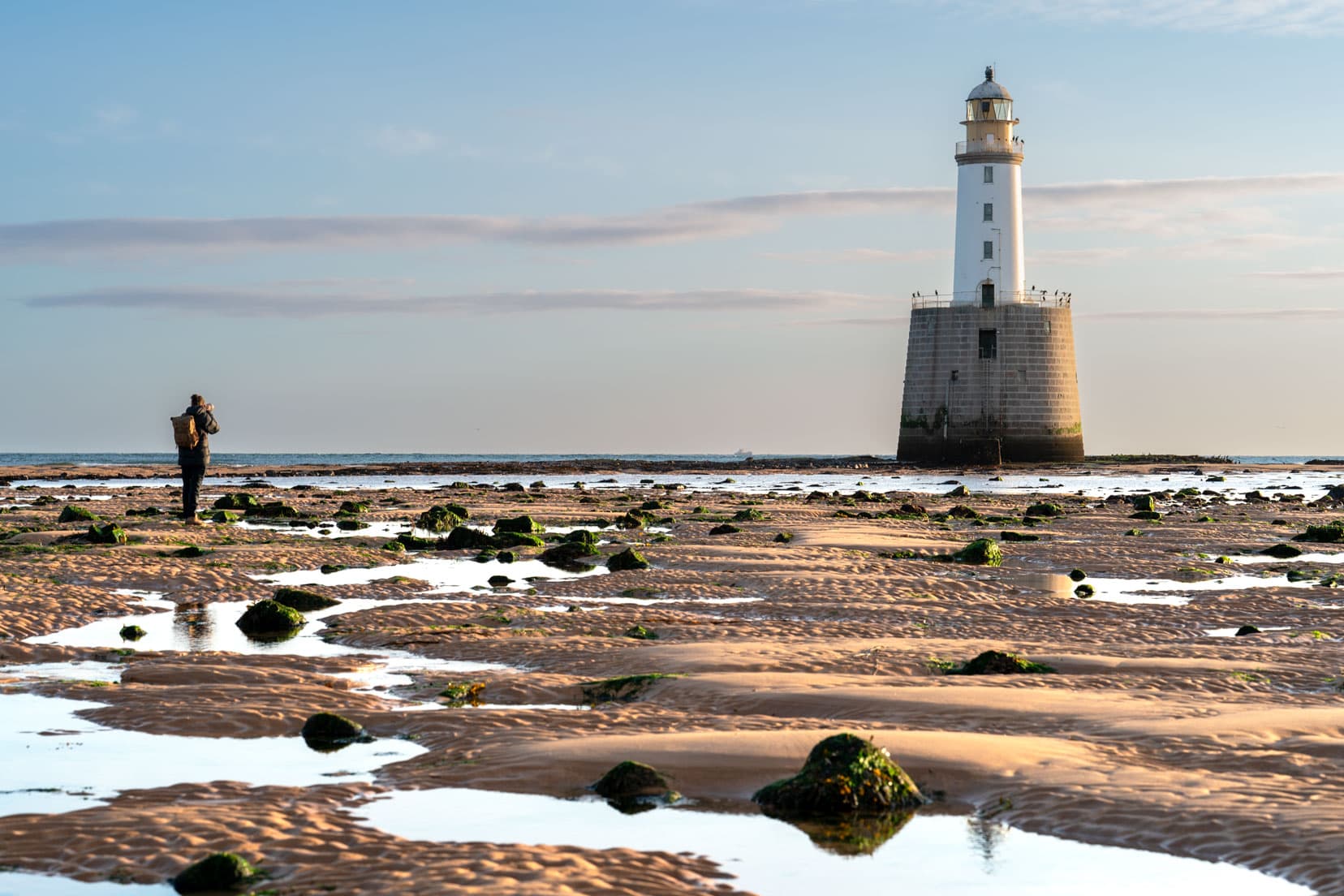
In a Nutshell: Discover Rattray Head, Aberdeenshire
- Location & Views: Nestled on Scotland’s northeast coast, Rattray Head offers panoramic views of the North Sea.
- Key Attractions: The majestic Rattray Head Lighthouse and extensive sandy beaches lined with towering dunes.
- Activities: Perfect for photography enthusiasts, especially at sunrise, nature walks along the beach, and bird watching in nearby reserves.
- Getting There: Easily accessible by car; about an hour from Aberdeen and 20 minutes from Peterhead. Public transport options are limited.
- Best Time to Visit: Access the lighthouse during low tide and early morning for the best light for photos.
- Amenities: Facilities are sparse—there’s a small car park with no onsite amenities, so plan accordingly.
- Interactive Map: Check out the interactive map below to pinpoint locations of interest and plan your visit efficiently.
Plan Your Visit: Click on the interactive map to start exploring Rattray Head, find specific routes, and check the location of the car park and best photo spots.
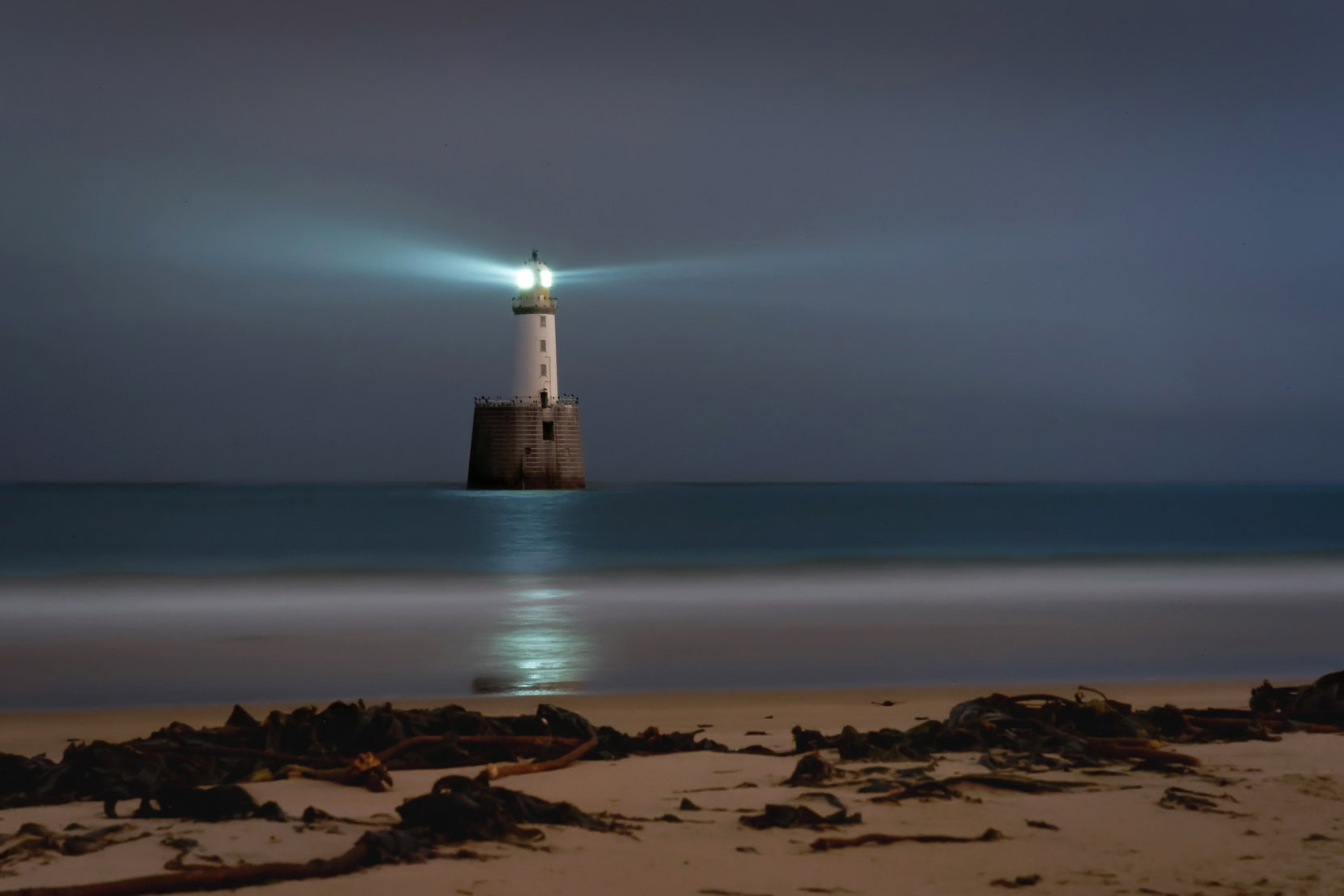
Explore Rattray Head with Our Interactive Map
Discover the paths, key landmarks, and scenic spots of Rattray Head with our easy-to-use interactive map. Click on the map below to start exploring, zoom in for detailed routes, and click on icons to learn more about each location.
Use the map by clicking the square icon at the top right to go full screen. The sidebar on the right includes a key to all marked points such as the car park, various trails, and notable photographic spots.
Rattray Head Lighthouse: A Beacon of History and Beauty
In Aberdeenshire’s county of castles, Rattray Head’s Lighthouse, rather than its castle, collects the accolades.
A Coastal Retreat
Nestled along Aberdeenshire’s serene coastline, Rattray Head Lighthouse offers a tranquil escape.
Here, the soft colours of the beach meet the crisp Atlantic Sea breeze, providing an isolated setting that is ideal for reflection and photography. It’s especially magical at sunrise when the lighthouse reflects on the wet sand.
Venture further, and you’ll discover towering golden sand dunes, some reaching up to 23 meters. Stretching 27 kilometres from St.Combs to Peterhead, the expansive beach is a highlight for anyone on a photography road trip, providing endless opportunities to capture stunning coastal scenes.

Echoes of the Past
Interestingly, Rattray Head is not just home to its famous lighthouse. As with so many areas in Scotland, Rattray Head used to have its own castle, but this one is a real hidden gem.
In 1790, a massive storm buried the castle, which is now hidden under a grassy mound. Today, all you can see is livestock grazing above its hidden ancient walls.
While the castle was already a ruin when it was engulfed, it adds a layer of mystique to the area, inviting visitors to ponder the tales of yesteryears.
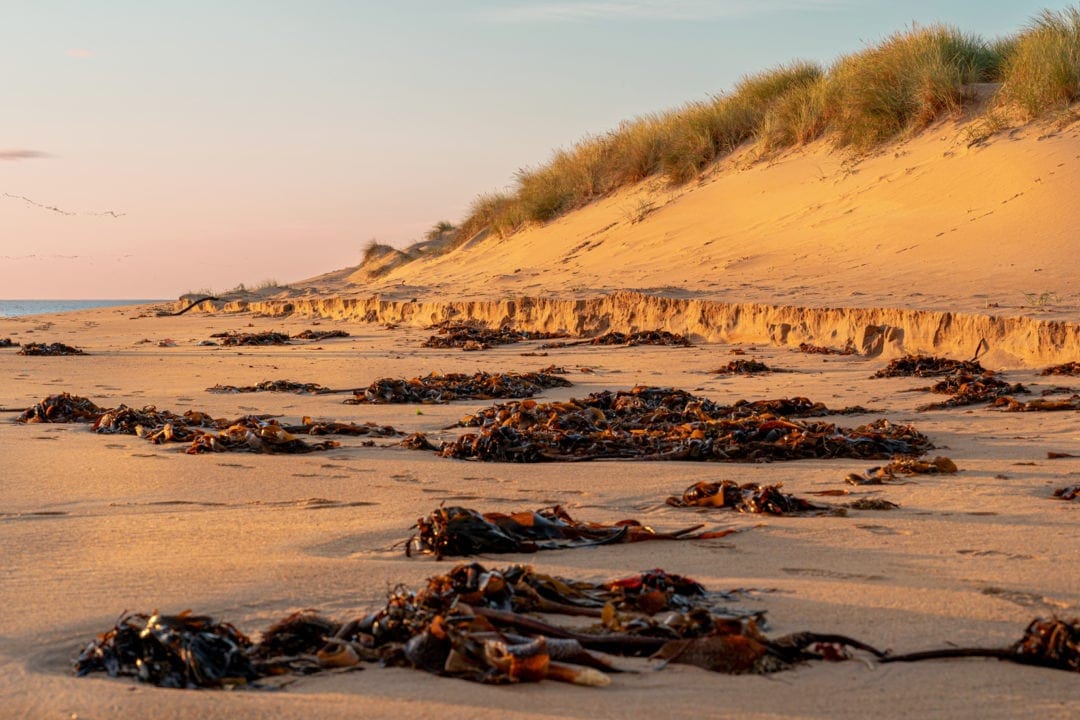
Architectural and Natural Harmony
As you explore, you’ll find that the lighthouse itself has stood the test of time and elements. Designed by the renowned engineer David Alan Stevenson in the late 19th century, it has guided countless mariners along this treacherous part of the coast.
Despite the adversities of time—including near misses by WWII bombs—it still stands today, a testament to its robust construction.
Initially built to house a foghorn and an engine room, the lighthouse became fully automated in 1982. Seabirds became its new keepers, using its high vantage points to scan for food in the waves below.
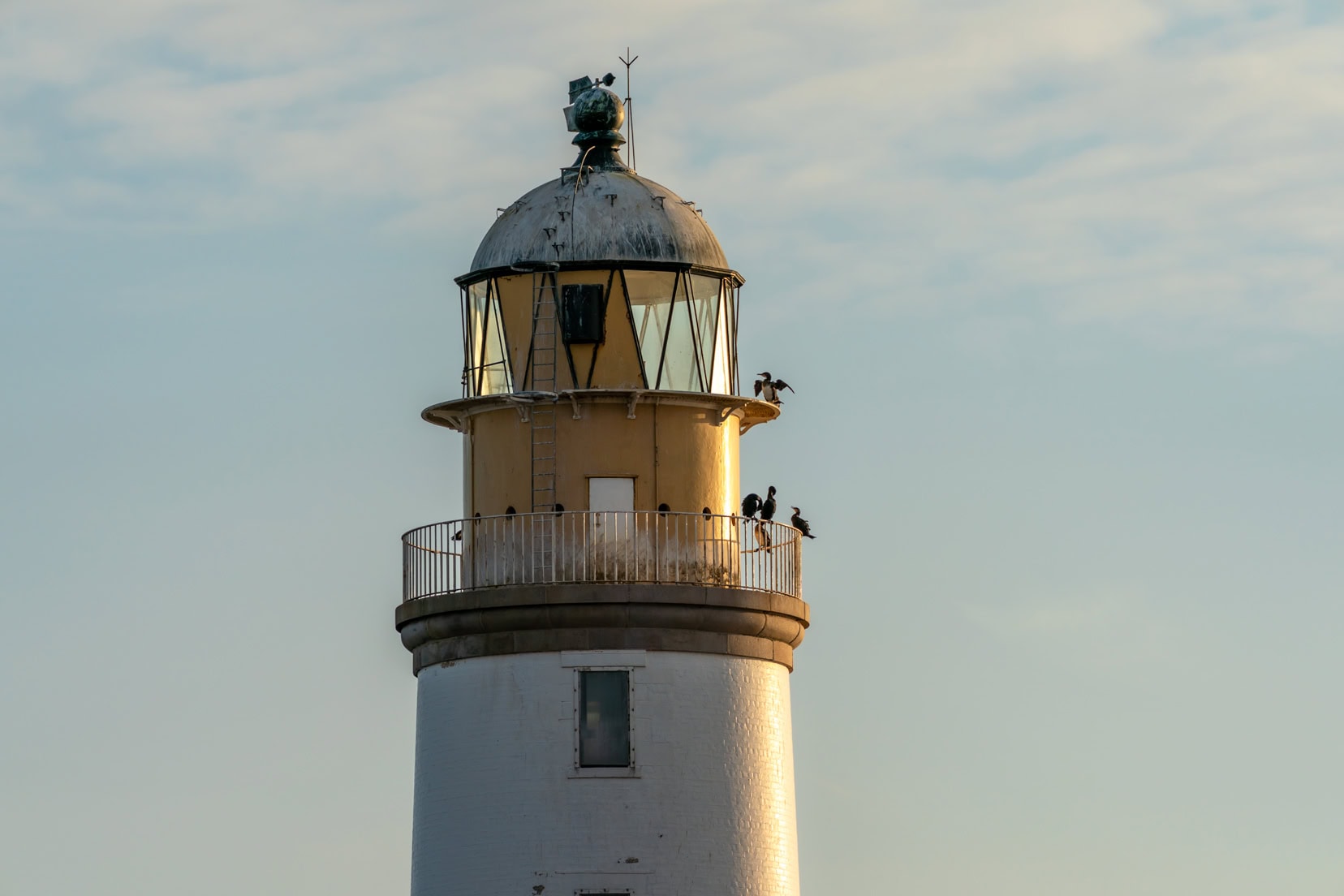
Planning a Trip to Scotland?
- 🚗 Hiring a car? We recommend getting a quote from DiscoverCars
- 🚐 Hiring a campervan? We recommend Motorhome Republic
- ⛑ Arranged your travel insurance? Compare quotes from World Nomads & Safetywing
- 🪪 Order your International Driver’s Licence online here
- 🏩 Booked your accommodation? We use Booking.com to find the best deals
- 🐾 Is someone pet-sitting for you? 🐾 We use and love TrustedHousesitters
- (Get 25% off at checkout for new memberships with our discount code: LIFEJOURNEY25)
How do I get to Rattray Head Lighthouse?
Location and Basic Directions
Rattray Head is beautifully situated on Scotland’s northeast coast within the Buchan area of Aberdeenshire.
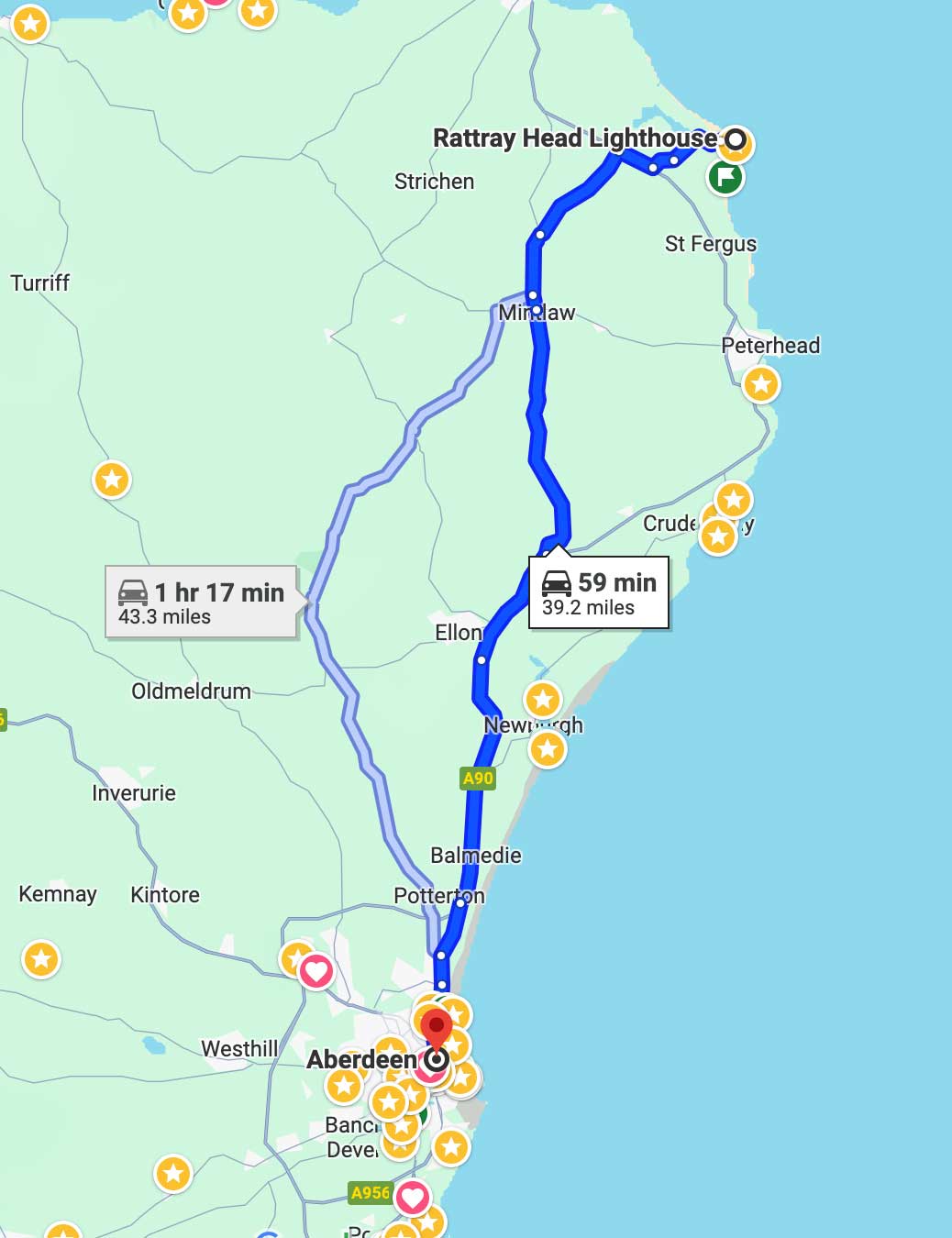
Planning your road trip to Rattray Head?
Don’t forget to use our handy Free Printable Road Trip Planner to efficiently organise your route and stops. Download a free copy here.
Driving Details
Driving is the most convenient way to reach Rattray Head, with scenic routes along major roads.
From Aberdeen: Start your journey on the A592 and then follow the A90 directly. This straightforward route offers coastal views and is roughly 40 miles (about 25 miles) and takes approximately one hour, making it an ideal day trip destination.
From Peterhead: For those coming from the north, it’s approximately a 20-minute drive from Peterhead.
Travelling with your significant other? Make sure to read our road trip tips for couples for a harmonious journey.
Public Transport To Rattray Head Lighthouse
For those preferring public transport, a bus service from Peterhead travels north along the A90. However, the bus doesn’t stop at Rattray Head. The nearest bus stop is about 4.5 miles (7.2km) from Rattray Head, so plan for a taxi or a long walk if you choose this option.
Ideal Road Trip Stop
Make Rattray Head a key stop on your coastal road trip from Aberdeen to Inverness and explore the North Coast 250.
While Rattray Head isn’t marked as a main tourist attraction, its seclusion makes it an appealing detour for those looking to discover hidden gems off the beaten path.
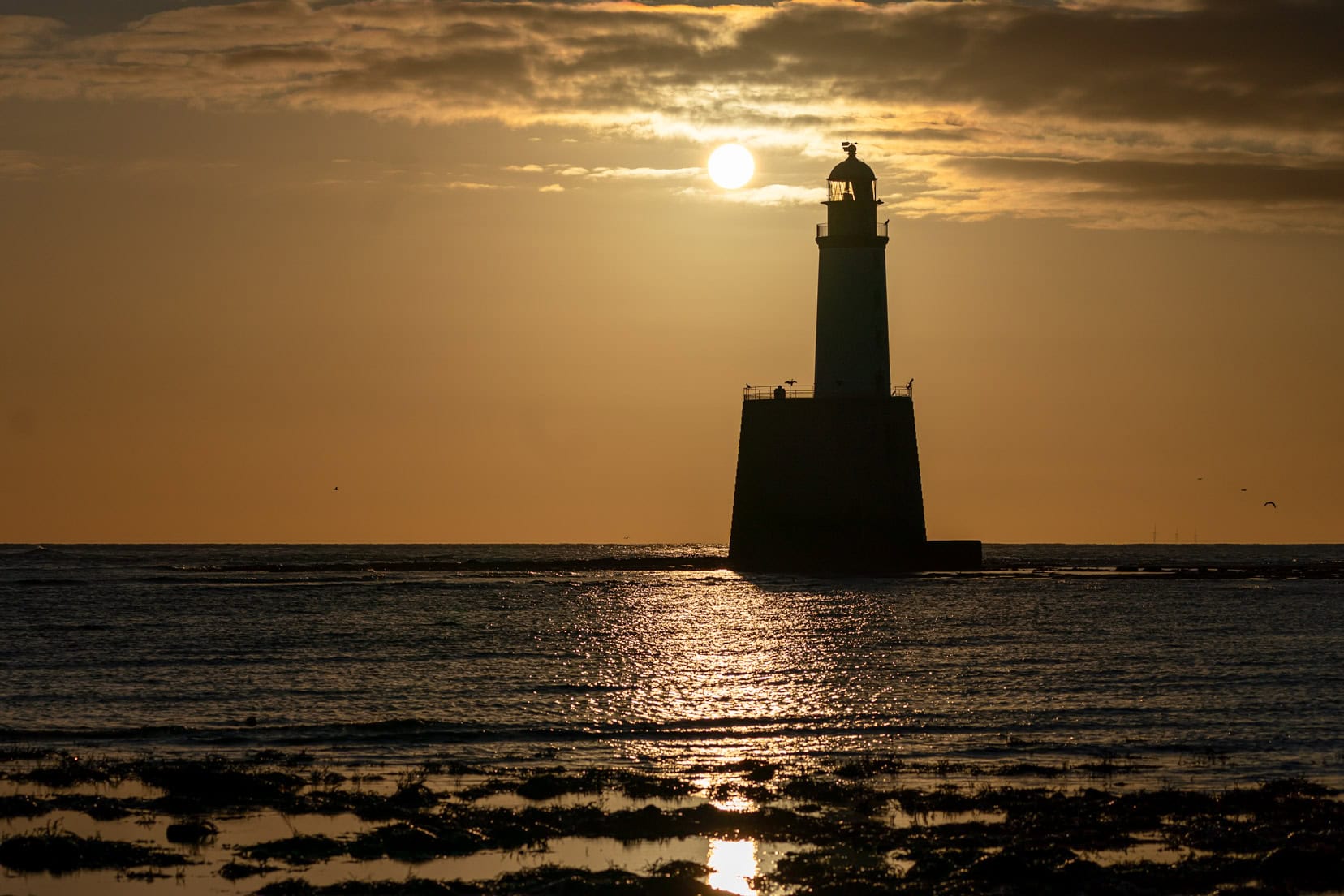
Can You Walk to Rattray Head Lighthouse?
Getting to the Lighthouse
The journey to Rattray Head Lighthouse begins in a small car park by the old keeper’s accommodation. From there, a small gate opens to a pathway that meanders through the dunes, offering a short but scenic walk to the beach.
For a detailed view of this route, please see the map.

Exploring the Rattray Head Dunes
As you climb the steep sand dunes, you’re rewarded with a stunning coastline vista. This area is not just beautiful; it’s also steeped in history. Along the shore, you might notice remains of past shipwrecks. Local stories suggest these were not accidents but part of insurance scams, where shipowners would deliberately ground their vessels on the rocks.
Photographic Opportunities
These dunes and the surrounding area provide perfect opportunities for photography, especially during low tide when the sand reveals more of its secrets. This is also the best time to get closer to the lighthouse, as the receding waters expose paths seldom seen at higher tides.
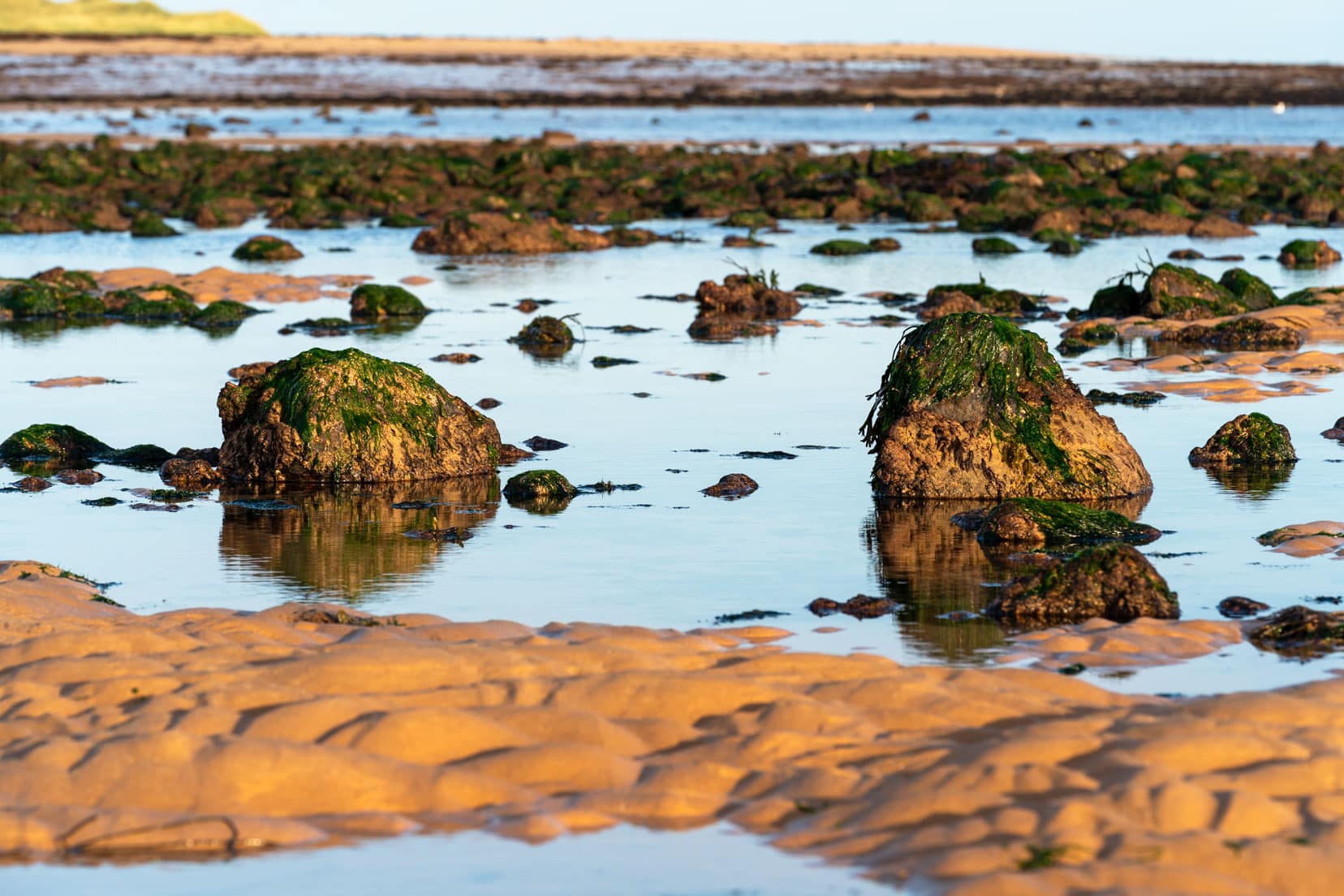
Arriving at night to capture some long-exposure shots highlights a different scene altogether. Remember your tripod and wet-weather gear.
I played with exposure times and had to time the rotating light to get the image until I had the image I was looking for.
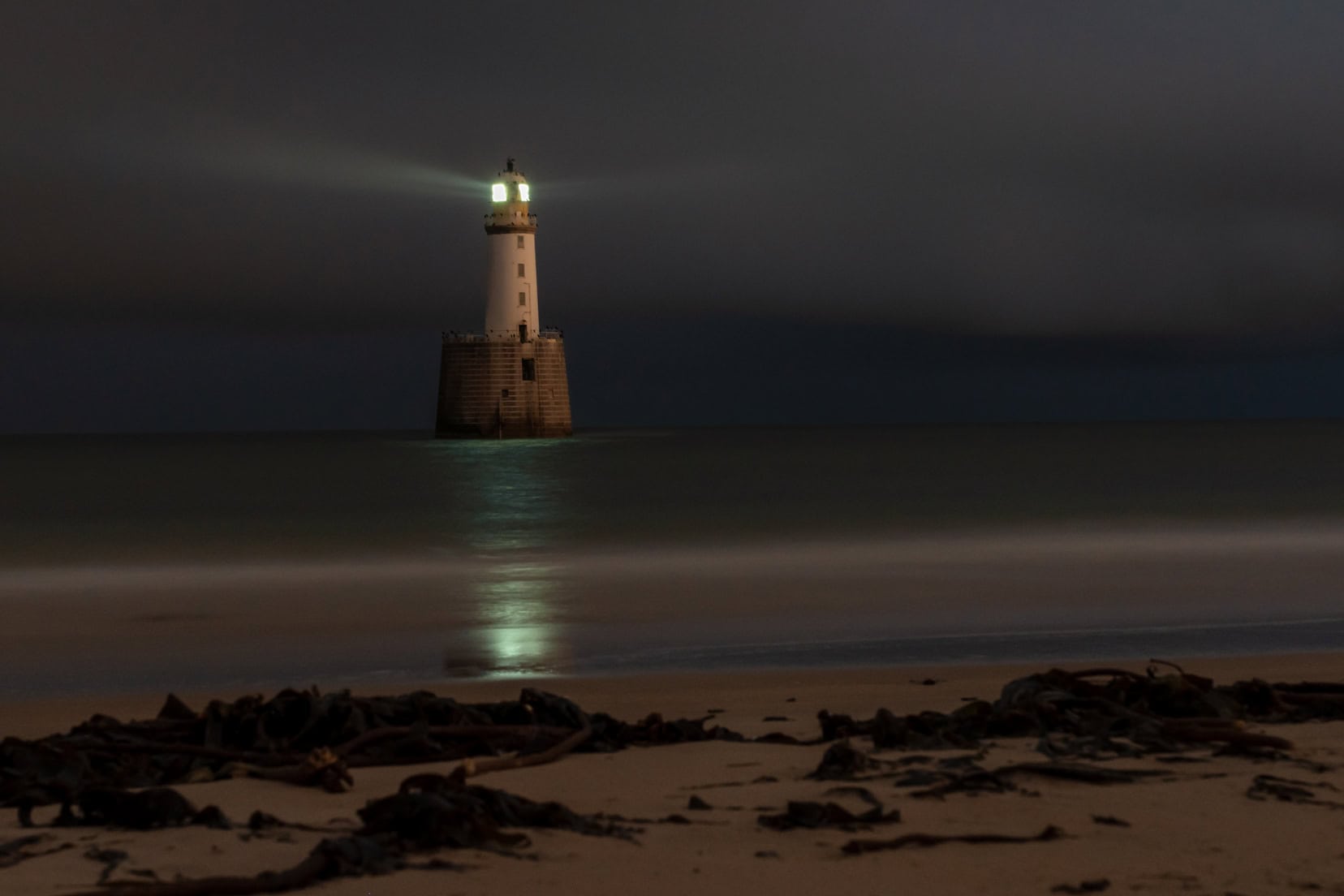
Visual Highlights
- The high sand dunes along Rattray Bay offer a unique landscape that changes with the shifting sands and tides.
- As the tide goes out, the rugged features of the seabed become more pronounced, revealing pools of seawater and seaweed-draped rocks that make for dramatic photographs.
- From a certain vantage point through the dunes, the lighthouse appears as a sentinel watching over the coast, providing a perfect backdrop for memorable shots.
- Nighttime images provide a totally different landscape to work with.
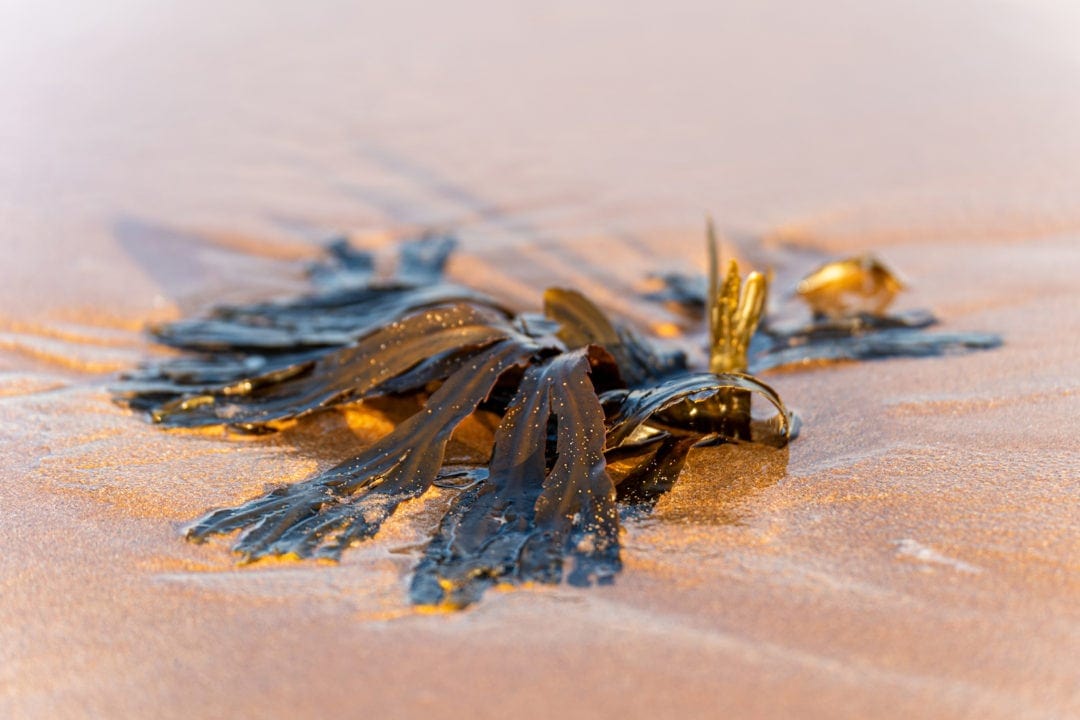
Photographic Paradise: Capturing Rattray Head
Rattray Head Lighthouse, perched on a rock tower and surrounded by a sandy causeway, offers a dreamlike setting for photographers.
The lighthouse becomes particularly captivating at low tide when it’s fully visible and mirrored in the wet sand.
Best Conditions for Photography
Capturing the lighthouse in its full glory often depends on the tide and time of day. The reflections in the wet sand can create dreamy, surreal images, particularly striking when the sun rises behind the 37-meter-tall beacon, casting a magical glow that enhances the scene.
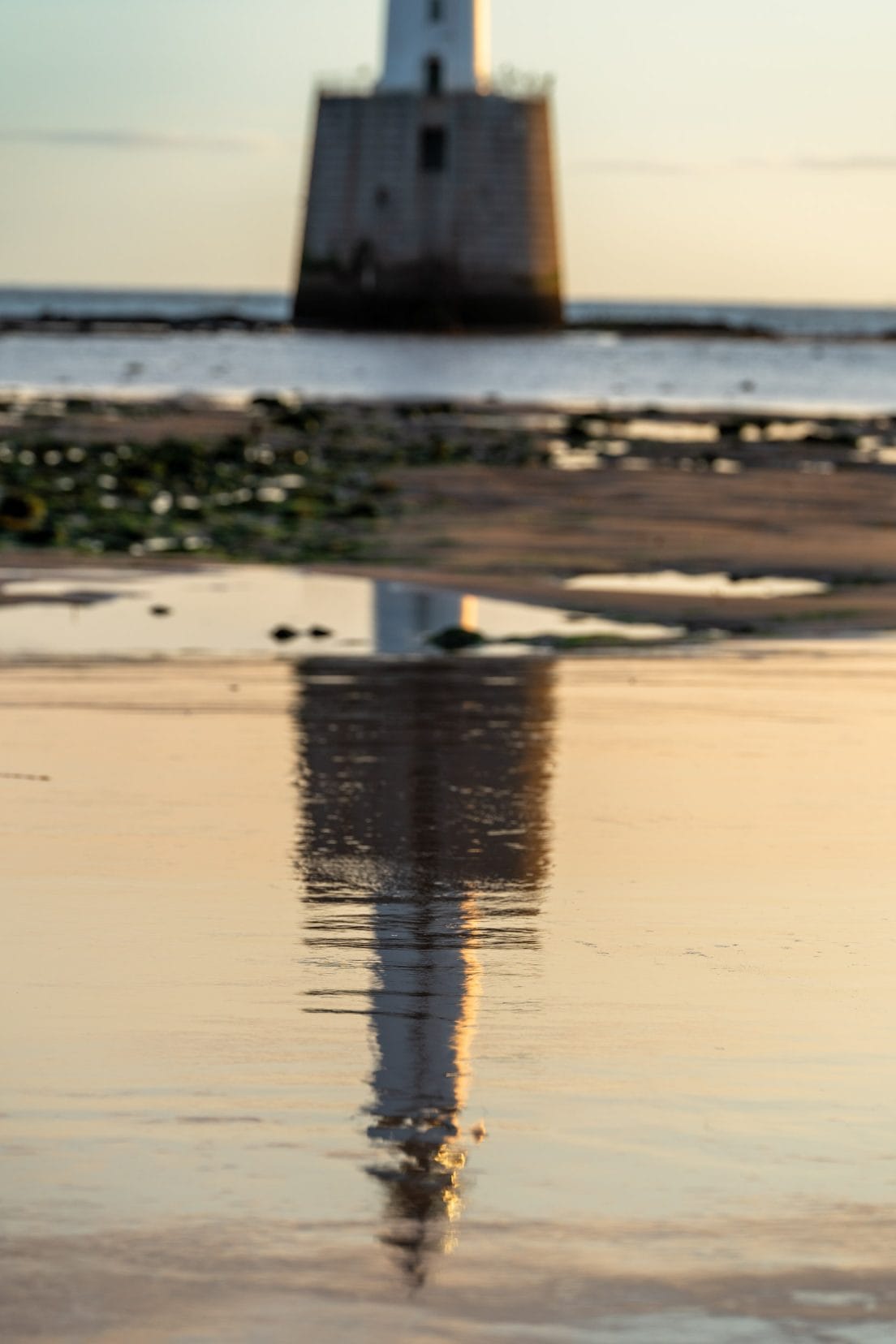
Ensure you capture the perfect shots with the right equipment. Check out our recommendations for travel photography gear.
Best Time to Visit Rattray Head
Optimal Photography Times
For photographers aiming to capture stunning shots of the lighthouse, timing your visit around sunrise is crucial.
The early morning light provides a magical illumination that is visually appealing and enhances the textures and colours of the landscape.
Night can often provide a moody sky and, when coupled with a long exposure shot, can result in some really captivating images.
Personal Experience and Tips
Arriving just after sunrise offered the best light. Despite being slightly late on our visit and finding other photographers already wrapping up, the scenes we captured were nothing short of spectacular.
Plan to spend at least an hour and a half here to make the most of the varying lights and scenes.
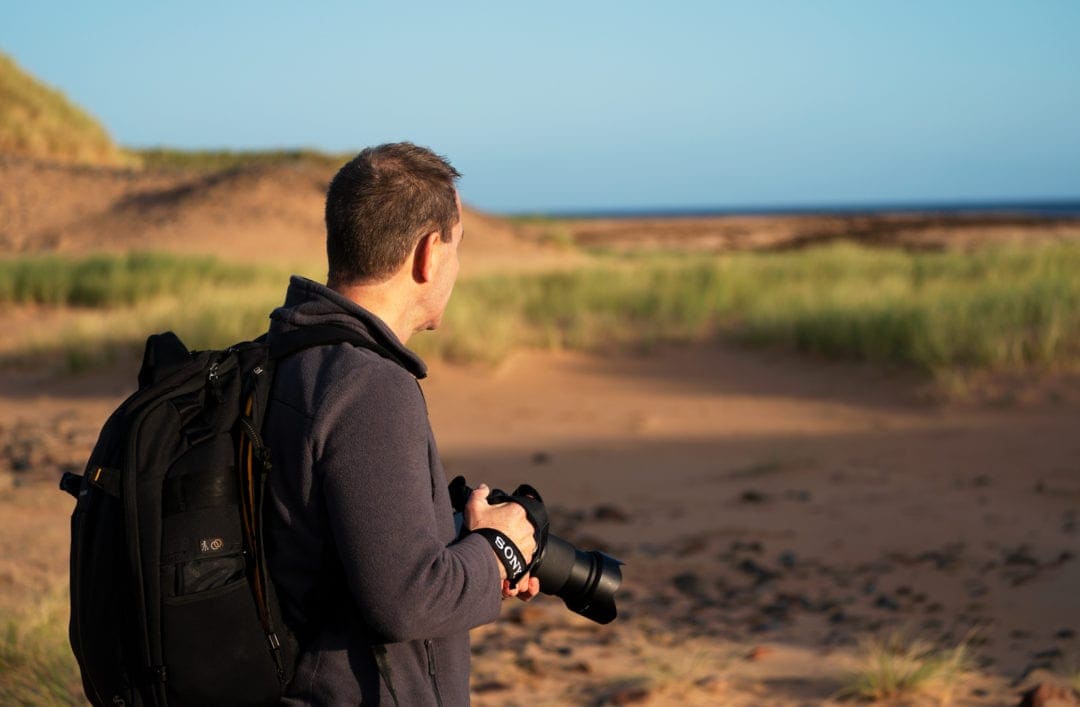
Seasonal Considerations
Visiting in autumn can be particularly rewarding. Early mornings during this season provide beautiful light and the chance to witness hundreds of pink-footed geese flying out from the local Loch of Strathbeg.
It’s a natural spectacle that adds a lively dimension to the serene landscape.
Planning Your Visit to Rattray Head
Rattray Head Car Park
Rattray Head’s small car park is at the end of a single-lane, rugged, uneven track with several potholes. It makes for a choppy ride before you even set sight on the ocean. The car park is situated just beside the old lighthouse shore station.
Parking is free, but only about a dozen car spaces are available.
Rattray Head Tide Times
Here’s a quick link to find out the current Rattray Head tide times.
The lower the tide, the closer you can get to the lighthouse.
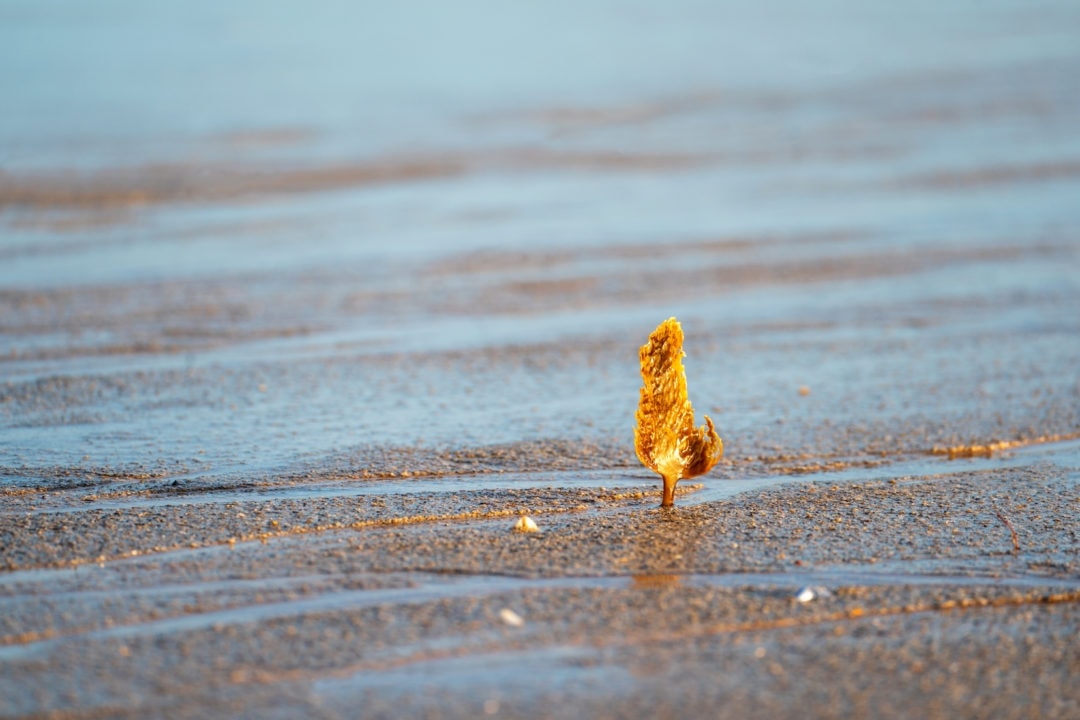
A Stroll Through Nature: Exploring the Surroundings
Rattray Head Walk
The sandy beach along Rattray can be walked from St Combs to Peterhead (See Map).
However, the most scenic part is from St. Combs to Rattray Head, which takes you past Strathbeg Nature Reserve. This walk is about 6 miles (9.5km) one way and takes approximately 3 to 4 hours.
Once at Rattray Head Lighthouse, you would need either someone to pick you up or a return walk to St.Combs (due to the lack of public transport at Rattray Head).
Rattray Head Lighthouse Walk
A much easier walk is to do a loop that includes the Rattray Head Lighthouse, past the Loch of Strathbeg, and the nearby ruins of St Mary’s Chapel.
You could start this loop at the Rattray Head small carpark or St Mary’s Chapel.
St Mary’s Chapel
St. Mary’s Chapel, built in the 13th century, is one of the oldest structures still standing in East Scotland.
Its ancient churchyard (kirkyard) remains by its side, and locals replaced the wall surrounding the yard in 1848. It is believed that William Comyn (Earl of Buchan) built it as a private chapel dedicated to his son, who drowned in a well.
For more information on the Chapel, read this leaflet Aberdeenshire Council produced.
Loch of Strathbeg
The Loch of Strathberg is a beautiful wildlife reserve just a few minutes’ drive from Rattray Head. The wetlands here are of international importance and are home to more than 560 wildlife species.
Entry is free, and there are many trails leading to various bird hides. We spent a good couple of hours there and loved it. We were surrounded by keen twitchers who were on the lookout for both the Greater and the Lesser Yellowlegs, which had been spotted at the Loch.
There was a buzz of excitement among the birdwatchers, all asking if we’d seen one. But not being up on our UK birds, we couldn’t tell anyone whether we’d seen one or not!
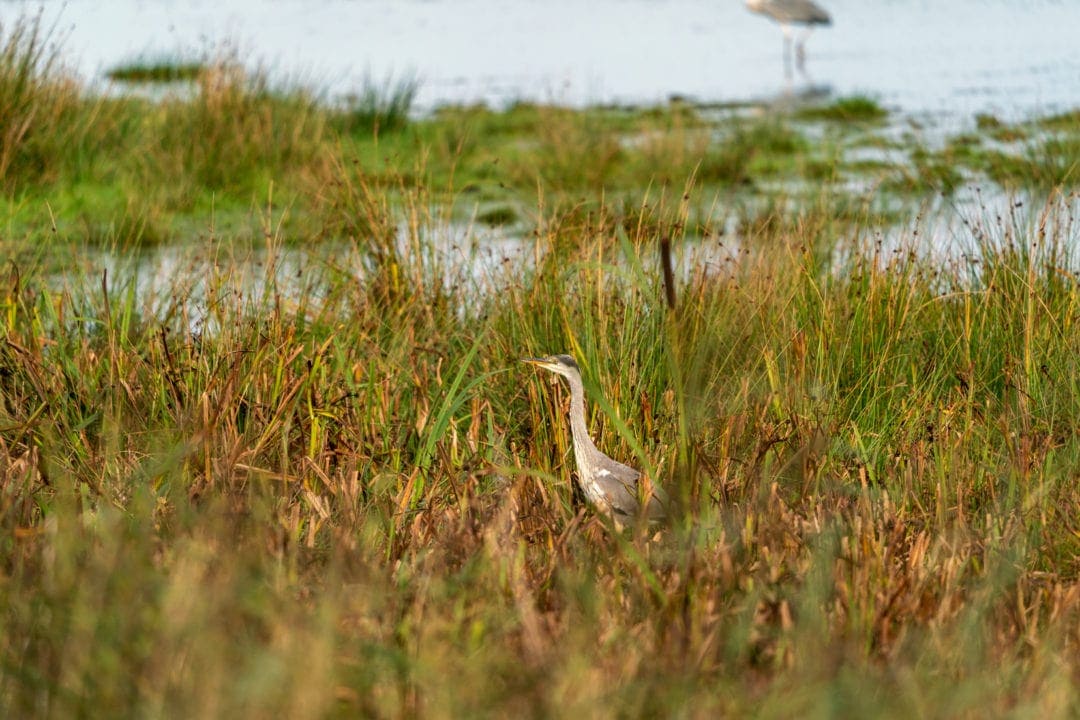
Strathbeg Wetland at Loch of Strathbeg
Wildlife and Scenic Delights Beyond Rattray Head
Discover More Seals:
Guaranteed Sightings at Newburgh Seal Beach: Missed spotting seals at Rattray? Head down the coast to Newburgh Seal Beach, where sightings are almost guaranteed. This location has consistently been a favourite, never disappointing with its frequent seal visitors.
Coastal Walks:
Stonehaven to Dunnottar Castle: The walk from Stonehaven to Dunnottar Castle is a must for lovers of coastal scenery. We’ve explored this path in all seasons, offering a perfect mix of breathtaking views and fresh sea air, ideal for those looking to enrich their travel experience with natural beauty.
Scottish Castle Heritage:
Explore Scotland’s Majestic Castles: If historical landmarks and Scottish heritage spark your interest, delve into the rich histories of Scotland’s castles. Our detailed guide on Scotland’s Castle Tours provides insights on whether you prefer a self-driven adventure or a guided tour, ensuring you capture the essence of Scotland’s storied past.

Rattray Head Lighthouse … That’s a Wrap
Rattray Head Lighthouse isn’t just a landmark; it’s a perfect spot for those who love the peace of an off-the-beaten-path beach and the charm of historical architecture.
It’s ideal for photographers looking to capture the raw beauty of Scotland’s coast or anyone wanting to enjoy a quiet day away from crowded spots.
Thinking about a visit to Rattray Head? It’s worth the trip, especially during low tide when you can walk right up to the lighthouse.
Pack a picnic, grab your camera, and maybe a pair of binoculars for birdwatching. And if you’re looking for more places to explore nearby, we’ve covered you with more tips and guides on our Scotland blog.
For straightforward advice and travel inspiration, check out our Travel Resources page. Let’s make your trip to Scotland a great adventure.
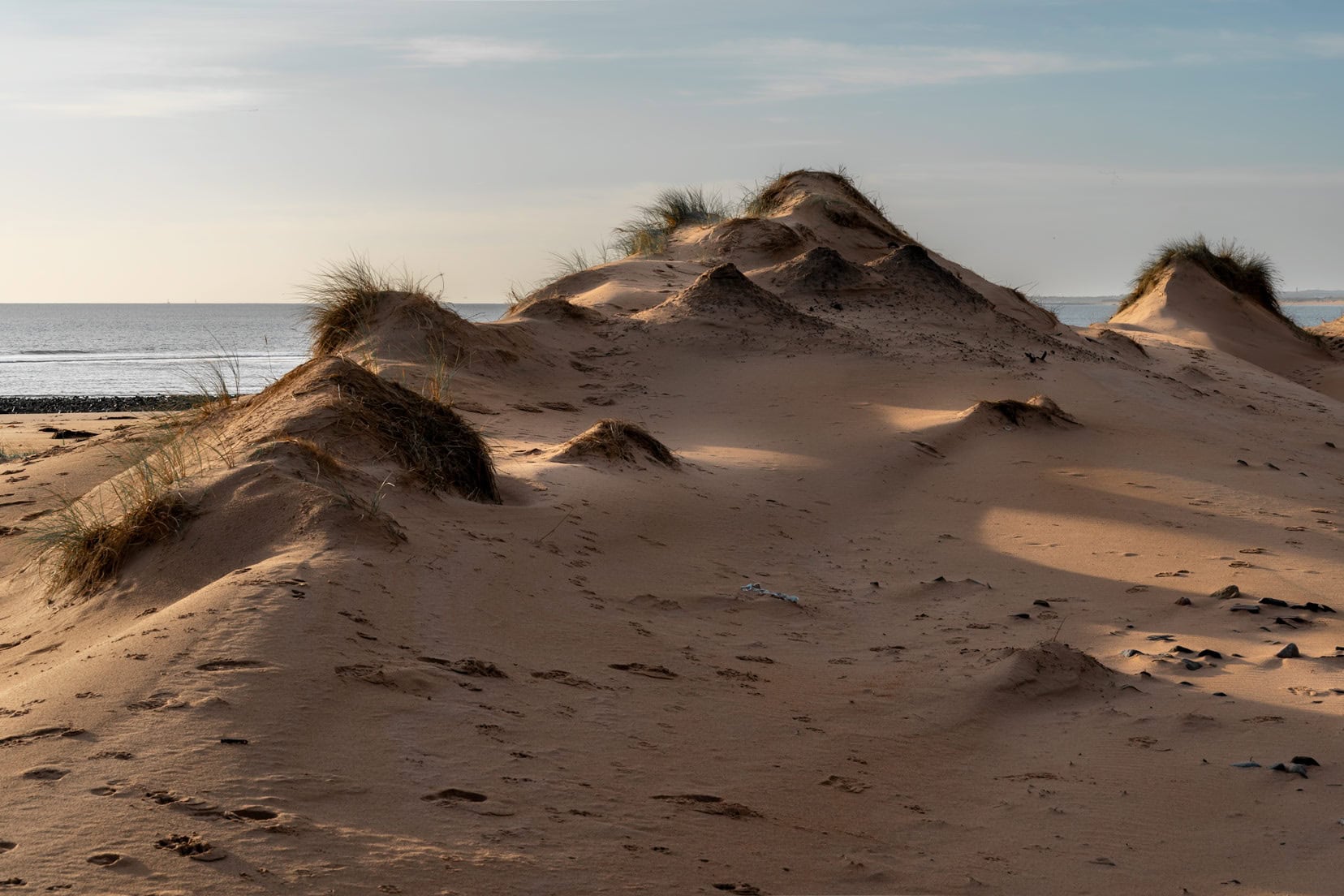
Rattray Head FAQs
1. What is the best time to visit Rattray Head Lighthouse?
The best time to visit is during low tide when the lighthouse and surrounding sandbanks are most visible. Sunrise provides magical lighting conditions for photography. Alternatively, capture a night shot of the lighthouse with its beacon ablaze.
2. Can I walk to Rattray Head Lighthouse?
Yes, you can walk to Rattray Head Lighthouse from the small carpark by the old keeper’s accommodation. It involves a scenic walk through the dunes and is accessible via a gated pathway.
3. Are there any facilities at Rattray Head?
Facilities are minimal, so visitors should come prepared. The nearest major facilities are located in Peterhead or Aberdeen.
4. Is there parking available at Rattray Head?
There is a small car park at Rattray Head near the old shore station. It is free but has limited spaces and the access road is rugged.
5. What should I bring to Rattray Head?
Pack weather-appropriate clothing, as conditions can change quickly. Bring water, snacks, and if you’re planning on photography, your camera gear. Walking boots are recommended for the sandy and sometimes slippery paths. For any nighttime images, you’ll need a tripod.
6. Can I see wildlife at Rattray Head?
Rattray Head is a great spot for watching seabirds and occasionally marine wildlife. The nearby Loch of Strathbeg is a haven for birdwatchers, especially in autumn and winter.
7. Is Rattray Head suitable for children?
The beach and walks can be enjoyable for children, but supervision is necessary due to the rugged terrain and tidal changes.
8. How do I get to Rattray Head using public transport?
Public transport options are limited. A bus runs north from Peterhead along the A90, but the nearest stop is about 4.5 miles from Rattray Head. A taxi from the bus stop to the lighthouse is recommended.

Planning Your Travels?
These are the travel resources we recommend and use when planning our trips.
- 🚘 Car Hire: We use DiscoverCars.com
- Motorhome/Campervan Rental: We highly recommend the Motorhome Republic
- 🪪 Order your International Driver’s Licence online here
- 🛏 Book Accommodation: We use Booking.com to find accommodation that suits our budget
- 🐶 Pet Sitting/Pet Sitters: Check Out TrustedHousesitters here (Use our Discount code: LIFEJOURNEY25 for 25% off. )
- Activities and Experiences: Get Your Guide and Viator
- Travel Insurance: Safetywing or World Nomads
- 🥾 Travel Gear and Accessories: Check out our top picks here — Lifejourney4two page on Amazon
For a more thorough list, visit our Travel Resources page here.

